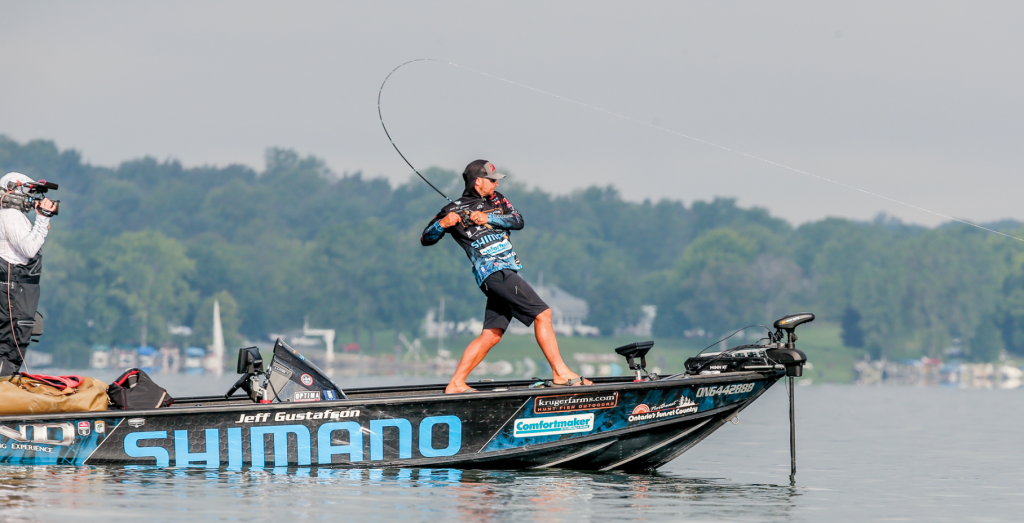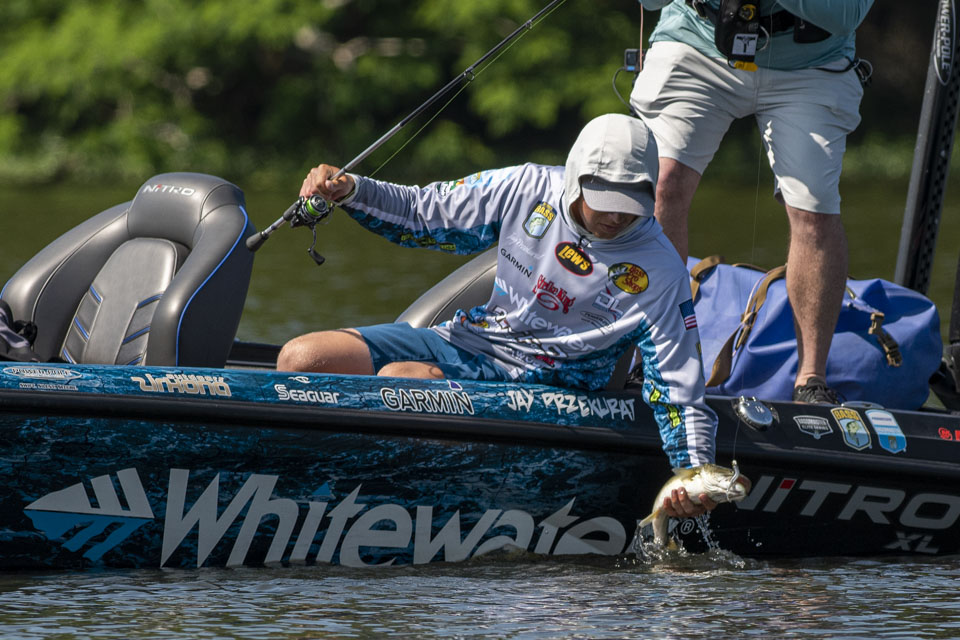
Visit the Tennessee River Valley and you’ll hear a frequent proverb among fishermen. “Playing with smallmouth is like playing with fire,” the locals will utter. “Eventually you’re going to get burned.” When northern fishermen hear this common saying, they scratch their heads. To them, a smallmouth is a hyperaggressive, nonstop eating machine.
Northern smallmouth are about as reliable as an Ariens snowblower after a 2-foot blizzard, or pushing the power button on the Yamaha outboard minutes before takeoff. In reality, the smallmouth disconnect between northern and southern fishermen has everything to do with forage.
“People think patterning smallmouth is so intimidating,” said Elite pro Jay Przekurat, who last year broke the Bassmaster Elite Series record for heaviest total of smallmouth ever weighed. “I’ve seen several Elites get all worried and worked up over smallmouth. We northerners sort of laugh at that. There’s no disrespect; it’s just that our experience helps us understand the different levels of dependability.”
According to Przekurat and fellow smallmouth stalwart and Bassmaster Classic winner Jeff Gustafson, bronze beauties can be placed into five diet-distinct classifications. On this smallmouth continuum, the lower number equates to greater reliability.
1) Ultra-reliable
Smallmouth cramming crayfish
“When I’m targeting smallmouth that are eating crayfish, there’s really no doubt that I’m going to catch fish; it’s just a matter of the caliber,” said Przekurat. “A crayfish is like a turtle. It can only move so far overnight. Crayfish are always hiding and tucking themselves under and between rocks, so I like baits that are on the bottom.”
In snaggy river situations, Przekurat opts for a weedless Ned rig, the smaller the better. For glacial crayfish lakes like Mille Lacs, he’ll opt for a 3/8-ounce Strike King Structure Jig with a Menace (blue craw) trailer.
“When people come up to Lake of the Woods I always tell them to first find sand,” said Gustafson. “Where the sand meets the rock, that’s where you catch smallmouth all summer long because that’s where the crayfish are. The hotter and brighter it is, the better those smallmouth are going to bite. The crayfish get more active, and then the smallmouth are more active. With cooler, cloudier weather, they get a little more fickle and usually end up sliding deeper. But even then, they’re pretty reliable.”
Gustafson will throw a Bagley Sunny B or Diving B1 to cover ground before slowing down and pitching the Ned rig.
2) Steady Eddy
Smallmouth eating yellow perch
“Perch move, but they don’t move as much as you think,” explained Przekurat. “There are several lakes around me in central Wisconsin that are these glacial bowls. Around the edge of the bowl is sand grass. That’s the No. 1 ticket to finding perch smallmouth. They’ll be a foot or two off the bottom. It’s the same exact deal on Lake St. Clair and several lakes in New York.”
Przekurat said it’s not uncommon for perch to roam a mile from one day to the next. Reconnecting with them takes some work, but it’s worth it.
“You know they’re not too far, and then you just have to put in the zigzag pattern. When you finally see that pocket of fish on your LiveScope, perch-relating smallmouth are super easy to catch. They’ll eat it immediately, usually before it hits the bottom.”
Przekurat’s favorite perch-related technique is a Baby Z Too (Arkansas shiner) on a drop shot. Other productive baits include a 5XD crankbait (chartreuse perch), Alabama rigs and a 3/8-ounce tube for snapping in the grass.
Gustafson has had success with both sand grass and cabbage fields that hold perch.
“I have been burned on those on St. Clair perch fish before, but you know that if you’re around them, they show themselves real quick. If they’re not on your waypoint, you just have to put your trolling motor on a higher gear and find them. If it’s calm, I’ll start with a walking topwater like a Bagley Knocker B. If it’s windier, I’ll throw a jerkbait to start. Once I find them, I’ll slow down with a 4- or 5-inch Jerk ShadZ on a drop shot.”

3) Rock Solid
Smallmouth scarfing gobies
Gustafson and Przekurat put Great Lakes smallmouth in another category entirely because of gobies, an invasive baitfish introduced more than two decades ago. Round gobies are unique to the Great Lakes, and while smallmouth love these bottom-dwelling feeders, they’re usually paired with other baitfish that are also eating plankton.
“There has to be some kind of structure on the bottom,” Przekurat went on. “If you’re fishing a 20-foot rock pile, and you catch a goby, that’s actually a good sign.”
“It would blow your mind how many gobies are on the bottom of Lake Ontario,” recalled Gustafson. “Using the Aqua-Vu, you can see places where they are thick; it looks like there’s millions of gobies. But where the bass are, the gobies disperse and hide a little better. In general, Great Lakes gobies love to hang out around rock piles and shipwrecks, and the smallmouth will be hunting the gobies. Those summertime gobies are super consistent and reliable when they’re playing the guard-the-rock game.”
Gustafson and Przekurat both mentioned that gobies love to pursue smallmouth spawning grounds. But in the springtime, a change in wind can change everything on the Great Lakes.
“At Sturgeon Bay, you can literally catch 100 smallmouth one day, and then the wind switches, your spot is blown out and you’ll catch zero,” Gustafson added. “The wind blows that warmer surface water and everything changes.”
“With gobies, you want to find a mixture of bigger boulders and sand,” said Przekurat. “I use the Fat Coffee Tube — 2.75 inches — in the light melon purple color. It’s lighter than green pumpkin and blends in with the bottom more. They get tricked into thinking it’s a goby, and they snatch it up.”
“After four years on Lake Ontario, I’ve learned to love a green pumpkin Hula StickZ on a Ned Rig. I also use a drop shot with a short leader,” Gustafson said. “When fishing around gobies, keep the leader 10 inches to a foot off the bottom.”
4) Wildcard Worthy
Smallmouth munching minnows (alewives, smelt)
“Alewives come in and spawn after the smallmouth spawn,” said Przekurat. “This is usually summertime up north — like later June and July. During that time, you can actually imitate alewives by throwing spybaits and big swimbaits.”
Przekurat cautioned that alewives spawn in odd areas, not just your typical shallow rock and sand.
“After the spawn, the patterns just go nonexistent. The nice part is that you can tell when it’s over. During the spawn, you’ll see hundreds of dead alewives floating around. When you don’t see those, that’s when you know the pattern is going away. After the spawn, alewives roam and live in no-man’s-land, so you’ll need electronics to locate them.”
“Smelt are a big deal for us the second half of the summer on Lake of the Woods and Rainy Lake,” added Gustafson. “These are my favorite smallmouth to fish for, but they can also break your heart. Often they do suspend and go wandering, but usually they relate to a point or a hump. If the wind is blowing on it, that’s a good thing. If the wind slacks off, the bait will go deeper. Forward-facing sonar is now making those fish a lot more predictable than they used to be. You can still find the dream school, and the next day the smelt are gone, and the fish are gone with them. That’s what happened to me last year at Oahe. After Day 1, they moved, and I wasn’t able to relocate them. My go-to smelt bait is a Jerk ShadZ on a Smeltinator jig.”

5) Danger – Proceed with Caution
Smallmouth chewing shad
It’s true that Gustafson won an Elite Series Tennessee River event two years ago with solely smallmouth. “They were shad eaters, but when I won, that was full winter, and the bass were just waiting for shad to float over them. For years, people have been picking me to win these reservoir tournaments because they have smallmouth, but the smallmouth fishing I do back home has nothing to do with reservoirs. Reservoir bass relate to what the shad are doing.”
Przekurat is willing to target shad-relating smallmouth, but he trusts only the current conditions.
“You have to let the smallmouth tell you what’s happening that specific day. One day they will be on a 4-foot rock hump, but just because they were there before, they likely won’t be there again. This happened to me on Lake Cherokee. I was fishing a shallow rock flat one day, and then the next day that smallmouth is 30 feet down over 100 feet. The new technology makes it a lot easier, but in general, when they’re around shad, that’s the worst time to be able to depend on a smallmouth.”




